Reaching out to Latin America: Xi Jinping Invites Argentinian President to Beijing
On February 4th, Chinese President Xi Jinping and Argentinian President Cristina Fernandez de Kirchner met in Beijing, following up on talks that started during Xi’s visit to Argentina in July 2014. Other high-ranking officials from both countries also met, including China and Argentina’s respective foreign ministers Wang Yi and Hector Timerman. Both leaders stressed Argentina and China’s similarities as major developing nations and “complementary” economies, which they hope will serve as a basis to develop the two countries’ bilateral relationship. The leaders signed 15 agreements on topics ranging from construction of infrastructure in Argentina, including transportation networks and nuclear plants, to technological advancement, military alliances, and cultural exchanges. In addition, the government leaders pledged more cooperation within international institutions, especially a coalition of developing nations within the United Nations called G77, thus covering a wide spectrum of ways to strengthen ties.

Chinese and Argentinian leaders first began talking in July 2014 when Xi and Kirchner established the China-Argentina Inter-governmental Standing Committee. China and Argentina both have motives to be strengthening cooperation with each other. Argentina’s economy is suffering: in August 2014 it defaulted on its debt, and inflation and unemployment are on the rise. China, being its second largest trading partner, is a logical choice to help stimulate its economy. China is also looking for countries with which to trade and boost its economy following a year of record-low growth in 2014. To do so, it has reached out to Latin America through the (CELAC); a China-CELAC summit in 2014 resulted in the signature of 140 bilateral agreements and the creation of a $35 billion investment fund. Although during the 20th century the United States was more present in Latin America, today the region generally views China more favorably, so it makes sense for China’s government to capitalize on popular opinion. In a region of developing nations, these alliances give China an economic boost and help it compete with the United States.
For now, China is focusing on Argentina. One of the major projects the two countries agreed to pursue during last week’s meetings was the construction of two nuclear plants in Argentina. However, the agreement comes with favorable conditions for China, showing that the government is writing the rules on its own terms. The China National Nuclear Corporation, China’s state-owned nuclear operator, will oversee construction of the plant from start to finish, from design to fuel treatment through construction, meaning the Chinese government would have control over the entire project. This is a major step for the Chinese in nuclear technology, especially because Argentina’s two other nuclear plants use technology from Canada and Germany. It seems that Chinese investment in Argentinian nuclear power is not only about its own economy but also increasing the influence of its own nuclear industry and making it more competitive with those of Western countries. In any case, the agreement also benefits Argentina by creating jobs at the new plant and taking pressure off its other two reactors.
However, although talks went smoothly at the highest political levels, some aspects of Kirchner’s visit angered the Chinese public. During her visit, Kirchner published a racist tweet mocking Chinese people’s accents in foreign languages, which she then disregarded as simple humor in a follow-up tweet. Although the government did not respond to the tweet, users on Sina Weibo, China’s equivalent of Twitter, reacted more violently, criticizing the Argentinian president and her country. The tweet was a major cultural misstep, demonstrating a lack of cultural sensitivity. Some of the agreements signed by the two governments during last week’s visit concerned not only political and economic aspects but also cultural ones, like travel visas. However, this means making ties not only at the highest political levels but also with China’s population, something that Kirchner apparently failed to understand.
Thus, it will be interesting to see how China’s relations with Argentina develop, economically, politically, and culturally. The fact that China is making a larger effort to reach out to Latin America, however, shows its desire to extend its influence in regions where the United States has traditionally held more clout. It remains to be seen whether China will act similarly to the way it did in Africa (where more than 200,000 thousand Chinese workers migrated in 2013) and use Chinese labor to build Argentinian infrastructure, which could anger locals looking for jobs. Either way, these efforts suggest that China is looking to take on a more influential international role, and is thus expanding its relations with other developing regions.
